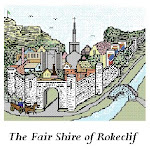As published in the White Birth newsletter
Rokeclif, Northshield, March 2009
The World of the Luttrell Psalter
Michelle P. Brown
Rokeclif, Northshield, March 2009
The World of the Luttrell Psalter
Michelle P. Brown
In the mid 14th century, Geoffrey Luttrell commissioned an artist team of scribes and artists to create the Luttrell Psalter. There is evidence of multiple artistic hands upon the Psalter. Unusually, some of its creators may have received room and board with the Luttrell household and be depicted alongside the Luttrell family. Even more remarkable is the inclusion of the peasant folk who lived and worked the Luttrell lands. This Psalter is unique for its many images of daily life such as plowing, harvesting and the mischief of children. While lacking the legal precision of William’s Doomsday book, the Luttrell Psalter does offer a broad record of life on Geoffrey’s medieval estate.
The reasons for the creation of the Luttrell Psalter were many, both worldly and spiritual. It was at once a celebration of the Luttrell family and its holdings and a memorial of the same to last beyond Geoffrey’s time. Awareness of mortality, not surprising to find within the medieval Christian faith, pervades the pages of the Psalter. Concern for his eternal soul led Geoffrey to make many provisions of charity in his will in exchange for prayers to be said for him after his death. Certain illuminations may be connected with these gifts to the Church. The bedecked war-horse Sir Geoffrey sits astride in one of the best known images was a mortuary gift to his parish church.
Other images use allegory to reflect the struggle of man’s soul. A naked youth faces the mouth of hell in one picture while Geoffrey sits in a boat rowed in one direction by his Sins and pulled forward in another by Truth and Mercy. In addition to visual double meanings, the positioning of the images within the text form added layers of interpretation and depth to a reading of the Psalter. One could say the words of the Psalter play with the illuminations.
While the text of the Psalter is pious the tone of the work is not without an element of entertainment. Grotesques may represent the twisted and sinful souls of humanity, but they also reflect great imagination and creativity given outlet. Alongside psalms of praise and images warning against various evils there is a child up a tree sneaking cherries and a feast with Sir Geoffrey sitting center table. While both of these images work into the religious nature of the work, for instance the likeness of Geoffrey’s feast table to a second image portraying Jesus at the Last Supper, they also enable a more mundane reading. Such events would be ones to which any on the estate could relate, whether as the naughty child or a servant at the feast, and make a personal connection with their reading of the Luttrell Psalter.
It is doubtful monks or friars still think to pray for Geoffrey Luttrell’s soul but the record of his life remains to entertain modern readers and the illuminations to inspire curiosity and wonder. While few today can read the Psalter’s calligraphy and the narrow subject may not be of high interest, simply for the beautiful images I recommend anyone take a look through The World of the Luttrell Psalter. For those with an interest in illumination or medieval books this scholarly work is a must to read cover to cover.
Amata Cromwell


No comments:
Post a Comment